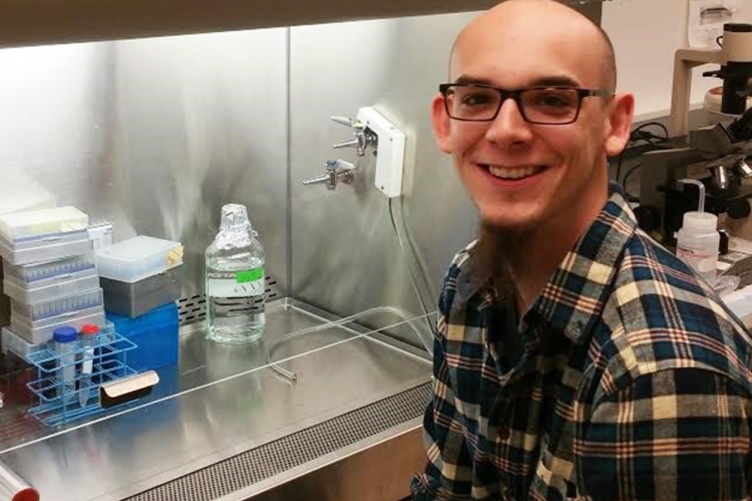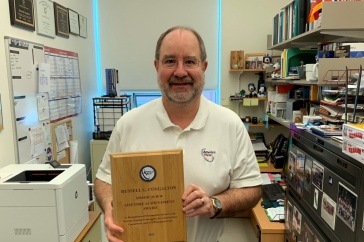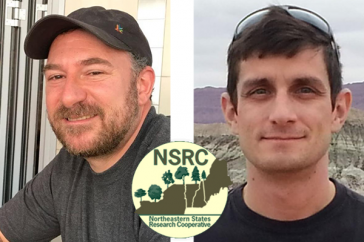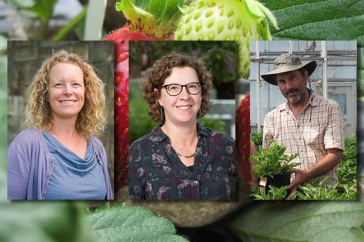
When doctoral student Krist Hausken went to Israel recently to work with a collaborator of his mentor Dr. Stacia Sower, he not only came back with a research breakthrough but a clear picture of what he wants to do after he graduates from UNH.
The Raymond native has been working in the laboratory of Sower, professor of molecular, cellular and biomedical sciences, who is well-known for her endocrinology research on sea lamprey, one of the two world’s oldest lineage of vertebrates. Recently Hausken returned from nearly two months of research in the laboratory of Sower’s collaborator Dr. Berta Levavi-Sivan at The Hebrew University of Jerusalem Faculty of Agriculture. His study-abroad experience was supported by Sower’s funding from the NH Agricultural Experiment Station at the College of Life Sciences and Agriculture and the National Science Foundation.
In Levavi-Sivan’s laboratory, Hausken successfully produced an important pituitary glycoprotein hormone -- thyrostimulin -- using yeast. It was the first time the hormone was artificially produced using yeast for any animal, including fish. Pituitary glycoprotein hormones under the control of the brain regulate reproduction, metabolism, and development in all vertebrates, basically everything that drives seasonal reproduction in all humans and animals.
It had previously been thought the lampreys did not have the same brain-pituitary control of reproduction as in all other vertebrates. However, the research in Sower’s laboratory has been the driving force in showing that these basal vertebrates, the lampreys, also have a similar brain-pituitary control of reproduction similar to all other vertebrates yet with some differences in the structures of the glycoprotein hormones. A landmark paper on this topic was published in 2015 in the journal Endocrinology.
“Pituitary hormones are really important for understanding how reproduction is regulated. It’s an important concept to understand how it works in fish, and more importantly, in the sea lamprey because the sea lampreys belong to the oldest lineage of living vertebrates,” Hausken. “Lampreys have similar basic regulatory structures such as the brain and pituitary that all other vertebrates have. But they have some unique differences in part since lampreys emerged at the beginning of vertebrate evolution and represent a very basic form of brain control that became more sophisticated during the course of evolution.”
According to Sower, “These hormones and respective receptors have been the subject of intense research due to the significance for understanding reproductive biology and for developing medical therapies, and agriculture and aquaculture uses.”
Sower and Levavi-Sivan, who have worked together for a few years, had wanted to artificially produce a recombinant thyrostimulin using yeast so they tasked Hausken with it for his time in Israel. Despite having little experience using the yeast system before he left, he succeeded in just six short weeks. Plans are to now reproduce his work at UNH.
“What our lab really seeks to understand is, how are these glycoprotein hormones the same, how are they different, and how have their structure and interactions evolved to become what they are in modern animals?” Hausken said.
While in Israel, Hausken also worked with graduate students from Germany and Greece, helping train them in cloning, identifying gene sequences, and extracted RNA. “It was an awesome experience. Just being able to be half way around the world and experience how other people live in a totally different culture, on top of learning how to do this cutting-edge science and working with another group that also is renown for what they do, was great,” he said. “This was a real outstanding research opportunity for me. As a graduate student, it is so valuable to see how other people do research.”
Sower compliments Krist on his research. “I consider Krist to be an outstanding graduate student who has excellent abilities to comprehend and perform the complexities of molecular endocrine research. To do collaborative research in an international laboratory was an incredible opportunity for him in which he took full advantage. Not only did he learn new techniques but had the opportunity of working with scientists from diverse cultures,” she said.
And now that he’s back in Sower’s lab, Hausken said he has a clear picture of what he would like to do after he graduates from UNH in 2017. “This experience in Israel made up my mind. I want to pursue a postdoc in comparative endocrinology. My long-term goal is to teach at a small academic institution and have a small research lab to work with undergraduate students. I want to go back to a place like Keene State, where I got my bachelor’s degree, and do what the professors at Keene State did for me,” he said.
This material is based upon work supported by the NH Agricultural Experiment Station, through joint funding of the National Institute of Food and Agriculture, U.S. Department of Agriculture, under award number 1003341, and the state of New Hampshire.
Founded in 1887, the NH Agricultural Experiment Station at the UNH College of Life Sciences and Agriculture is UNH’s original research center and an elemental component of New Hampshire's land-grant university heritage and mission. We steward federal and state funding, including support from the USDA National Institute of Food and Agriculture, to provide unbiased and objective research concerning diverse aspects of sustainable agriculture and foods, aquaculture, forest management, and related wildlife, natural resources and rural community topics. We maintain the Woodman and Kingman agronomy and horticultural farms, the Macfarlane Greenhouses, the Fairchild Dairy Teaching and Research Center, and the Organic Dairy Research Farm. Additional properties also provide forage, forests and woodlands in direct support to research, teaching, and outreach.
-
Written By:
Lori Tyler Gula, PhD | NH Agricultural Experiment Station | lori.gula@unh.edu | 603-862-1452



















































